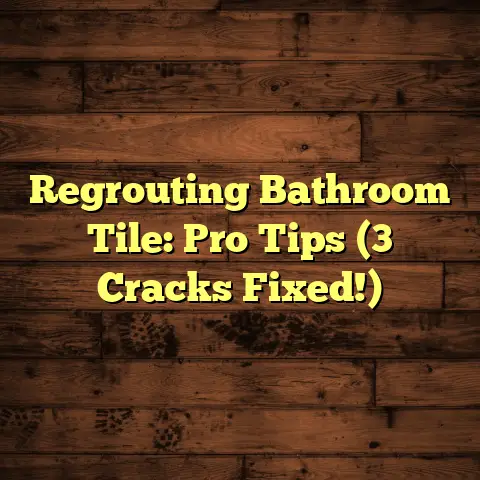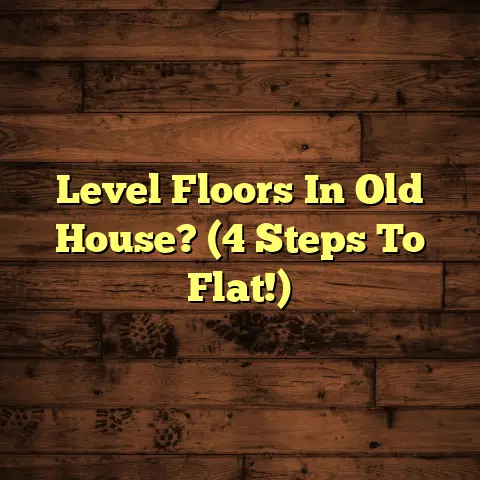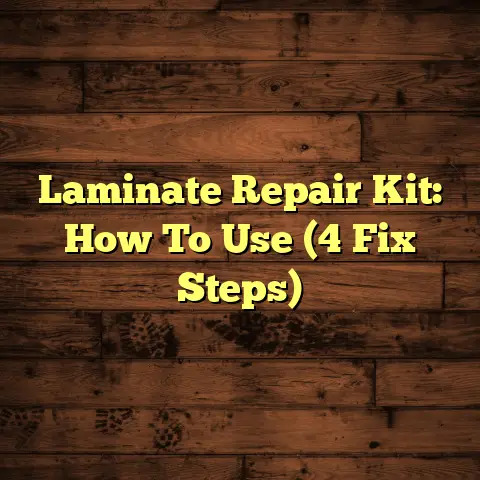How To Fill Gap Between Hardwood Floor And Wall? (Explained)
I remember the day vividly when I walked into a client’s home for the first time.
The room was beautiful, with rich hardwood floors that gleamed under the sunlight.
But then, I noticed it—a gap between the floorboards and the wall that seemed to grow wider with every passing moment.
It was as if the floor was trying to escape the confines of the room!
My heart sank, knowing that this was not just a cosmetic issue; it could lead to bigger problems down the line.
Over the years, I’ve encountered similar situations, and learning how to fill gaps between hardwood floors and walls has become second nature to me.
This task goes beyond simple aesthetics; it protects your investment and ensures the longevity of your flooring.
Today, I want to share my experiences, insights, and practical tips on this topic.
Let’s dive deeper into the nuances of filling those pesky gaps!
Understanding Why Gaps Occur
Before we jump into solutions, it’s vital to understand why these gaps appear in the first place.
Hardwood floors expand and contract with changes in humidity and temperature.
When the air is dry, the wood shrinks, creating visible spaces.
This is especially common in areas with extreme climate changes or homes with inadequate humidity control.
Seasonal Changes
In my experience, seasonal changes play a significant role in gap formation.
During winter months, heating systems dry out the air, leading to wood shrinkage.
Conversely, in summer, high humidity can cause the wood to swell, minimizing gaps temporarily.
However, if your hardwood isn’t acclimated properly before installation, you might see gaps forming even when conditions seem stable.
Tip: Regularly monitoring your home’s humidity levels can help prevent gaps from forming.
A range of 30-50% humidity is ideal for hardwood floors.
Installation Issues
Sometimes, gaps can arise from improper installation techniques.
If the floorboards weren’t laid with enough space for expansion or contraction, you might notice gaps forming over time.
I’ve seen this happen in homes where the flooring was installed too tightly against the walls or without adequate expansion joints.
Damage and Wear
As hardwood floors age, they can become susceptible to wear and tear.
If your flooring has been subjected to heavy foot traffic or damage from furniture moving around, it can exacerbate existing gaps or create new ones.
Tools and Materials You’ll Need
Once you identify a gap, it’s time to gather your tools.
Here’s a quick list of what you’ll need:
- Caulk or Wood Filler: Choose a color that matches your floor.
- Putty Knife: For spreading filler or caulk.
- Sanding Block: To smooth out any excess.
- Vacuum or Broom: To clean the area before filling.
- Cloth: For wiping away any mess.
Additional Tools for Larger Projects
If you find that your gap issues are extensive or recurring, you may want to invest in more specialized tools:
- Moisture Meter: This can help you check humidity levels in your home.
- Flooring Nail Gun: Useful if you need to re-secure loose floorboards.
- Screwdriver or Pry Bar: For adjusting baseboards or quarter-round molding.
How to Fill Gaps Between Hardwood Floor and Wall
Step 1: Clean the Area
First things first—clean the area thoroughly.
Dust and debris can prevent your filler from adhering properly.
I often use a vacuum for this step; it picks up everything without leaving any residue behind.
A clean workspace is essential for achieving a smooth finish.
Step 2: Choose Your Filler
Choosing the right filler is crucial.
I’ve tried both caulk and wood filler, and each has its pros and cons:
- Caulk: Flexible and good for minor gaps. It moves with the wood.
- Wood Filler: Better for larger spaces but can crack over time if not applied correctly.
For example, I once used a water-based filler that seemed great at first but shrank significantly as it dried.
Now, I prefer solvent-based fillers for larger gaps because they maintain their volume better.
Step 3: Apply the Filler
Using a putty knife, apply the filler into the gap.
Press it down firmly to ensure there are no air pockets.
It’s okay if it looks a bit messy at this stage; you can clean it up later.
Step 4: Smooth It Out
Once you’ve filled the gap, use a sanding block to smooth out the surface.
Be gentle!
You don’t want to damage your hardwood floor.
I often recommend sanding in the direction of the grain to prevent scratches.
Step 5: Clean Up
After sanding, use a cloth to wipe away any dust or excess filler.
This step is often overlooked but makes a significant difference in the final appearance.
Step 6: Let It Cure
Depending on the product you use, curing times may vary.
Make sure to read the instructions!
I usually wait at least 24 hours before putting any weight on it.
Step 7: Final Touches
Once cured, if necessary, you can apply a finish that matches your floor’s sheen—like satin or semi-gloss—to create a seamless look.
Costs Involved
Now, let’s talk about costs because they can vary significantly depending on your choice of materials and whether you’re hiring someone or doing it yourself.
When I first started using FloorTally, I was amazed at how it streamlined my cost estimation process.
For filling gaps like these, I usually spend around $20 for caulk or wood filler and another $10 for cleaning supplies.
If I’m hiring help, labor costs can add another $50-$100 depending on local rates.
FloorTally helps me input my local material and labor rates, making budget planning much more straightforward.
This allows me to provide clients with accurate estimates upfront, which they appreciate greatly.
Cost Breakdown Example
To give you an idea of what costs might look like:
- Caulk (1 tube): $5
- Wood Filler (1 container): $10
- Putty Knife (1): $5
- Sanding Block (1): $3
- Vacuum Rental (optional): $15 for half a day
Total DIY cost: approximately $38 (not including labor).
If hiring someone:
- Labor for Filling Gaps: $50 – $100 depending on job complexity.
So overall costs can range from $38 for DIY to upwards of $150 if you hire someone.
Common Challenges
I’ve faced several challenges while filling gaps over the years:
- Mismatch in Color: It can be tricky to find a filler that perfectly matches your hardwood floor.
I’ve learned to test a small area before applying it to ensure it blends well. - Shrinkage Over Time: Some fillers can shrink as they cure.
I always keep this in mind and apply a little extra filler to compensate. - Moisture Issues: If your home has high humidity levels, gaps may continue to form even after repairs.
Installing a dehumidifier can help maintain consistent humidity levels. - Inaccessibility: Sometimes gaps may be located near heavy furniture or appliances that are difficult to move.
In these cases, I recommend using a flexible filler that can be easily applied without needing to move everything around. - Floor Movement: If your flooring is still shifting after repairs, it could indicate deeper issues with your subfloor or foundation that need addressing first.
Alternative Solutions
Besides fillers, I’ve also tried other methods for dealing with gaps:
Baseboards
Installing or adjusting baseboards can cover small gaps effectively.
When I worked on one project, the homeowner opted for taller baseboards that not only masked some unsightly gaps but also added a stylish touch to their living room.
Quarter Round Molding
This decorative trim can hide larger gaps while adding character to the space.
For example, in a recent renovation project, I installed quarter-round molding along all edges of the hardwood floor which provided a clean finish while covering any irregularities.
Expansion Joints
For larger areas, especially in open-concept spaces, leaving expansion joints can allow for natural wood movement without visible gaps.
In one commercial project I managed, we installed expansion joints that were both functional and aesthetically pleasing by using matching wood strips.
Reinstallation
In extreme cases where gaps are too large or frequent, you might consider re-installing sections of flooring altogether.
This option is more labor-intensive but ensures a tight fit that won’t develop gaps in the future.
Maintenance Tips
Keeping your hardwood floors looking their best requires ongoing maintenance:
Regular Cleaning
Sweep or vacuum regularly to prevent dirt buildup.
I recommend using a vacuum designed specifically for hardwood floors as traditional vacuums can scratch surfaces.
Humidity Control
Use humidifiers or dehumidifiers as needed.
A simple hygrometer can help you monitor indoor humidity levels effectively.
Periodic Checks
Inspect your floors regularly for new gaps or issues.
During seasonal changes is an excellent time for this inspection; it allows you to catch potential problems before they worsen.
Unique Experiences
Throughout my career as a flooring contractor, I’ve come across some interesting experiences related to gap filling:
The “Perfectly Imperfect” Room
In one of my jobs, I encountered an old home with character—a beautiful rustic look but also significant wear around the edges where the floor met the walls.
The homeowner wanted to preserve the character while addressing concerns about dust collecting in those gaps.
Together we decided on using a natural wood filler that blended with the floor’s rich tones while also being eco-friendly.
The DIY Enthusiast
I once worked alongside a passionate DIY enthusiast who wanted to tackle gap filling themselves.
They were excited but overwhelmed by choices of fillers available at hardware stores.
I shared my experiences about various products and how they perform over time—ultimately helping them select something that matched their skill level and their floor’s needs perfectly.
Final Thoughts
Filling gaps between hardwood floors and walls might seem like a simple task, but it requires careful attention to detail.
Throughout my career as a flooring contractor, I’ve learned that taking the time to do it right not only improves aesthetics but also prolongs the life of your floors.
If you encounter gaps in your own home or projects, remember to choose the right materials, clean thoroughly, and maintain a consistent environment.
It’s all about keeping that beautiful hardwood looking its best for years to come!
Have you faced similar challenges?
What solutions have worked best for you?
Let’s share our experiences; every story adds value to our craft!





